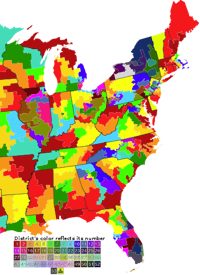
The census data, along with the Republican gains in state legislatures and governorships, means that Democrats face a grim decade in House elections. Regions and states which historically have supported Democrats lost seats or, in the case of California, for the first time did not gain seats in the House of Representatives. States that have become conservative Republican core areas — Texas, South Carolina, Georgia, Arizona, Utah, Florida, North Carolina, and Idaho — gained seats. Elected officials closely associated to the Tea Party, such as Senator DeMint, Senator-elect Rubio, Governor Brewer, and Governor Perry, are strengthened by these gains.
Compounding the difficulties for Democrats is the loss of muscle in state legislatures, particularly those states in which redistricting is not done by commissions. It seems as if the stars were all aligned against the Democrats in the November elections. For example, Democrats have all the power in California, but a state ballot iniitiative in 2008 placed redistricting power in the commission. The Governor of North Carolina is a Democrat and Republicans swept into both houses of the legislature, but in this quickly growing state, the Governor cannot veto redistricting (so districts wildly gerrymandered after 2000 to elect Democrats can now be drawn to elect Republicans — a swing of perhaps four House seats in that state alone.)
Even in those states which had no actual gain or loss in House seats, the census will show demographic changes within the state which require redistricting. How much will the cumulative impact of reapportionment favoring Republicans and redistricting within states favoring Republicans mean? A dozen seats? Two dozen seats? Though it is hard to predict precisely, the rise of sophisticated computer software will make the process much more effective. The shift in House seats also means a shift in electoral votes. Republicans would gain the equivalent of an average-sized state’s electoral votes in the next election simply because of reapportionment.
One aspect of Republican state legislative gains often overlooked is that these Republican state legislators will now be able to redraw state legislative districts to maximize Republican strength in the state legislative chambers. That means Democrats may be looking at power in state government ten years from now that is weaker than today. Because of all this, Democrat operatives are now pushing hard for nonpartisan redistricting. The argument would be more convincing if it had been made by Democrats after the 1980 or the 1990 censuses. As it is, such talk now simply sounds like sour grapes.



